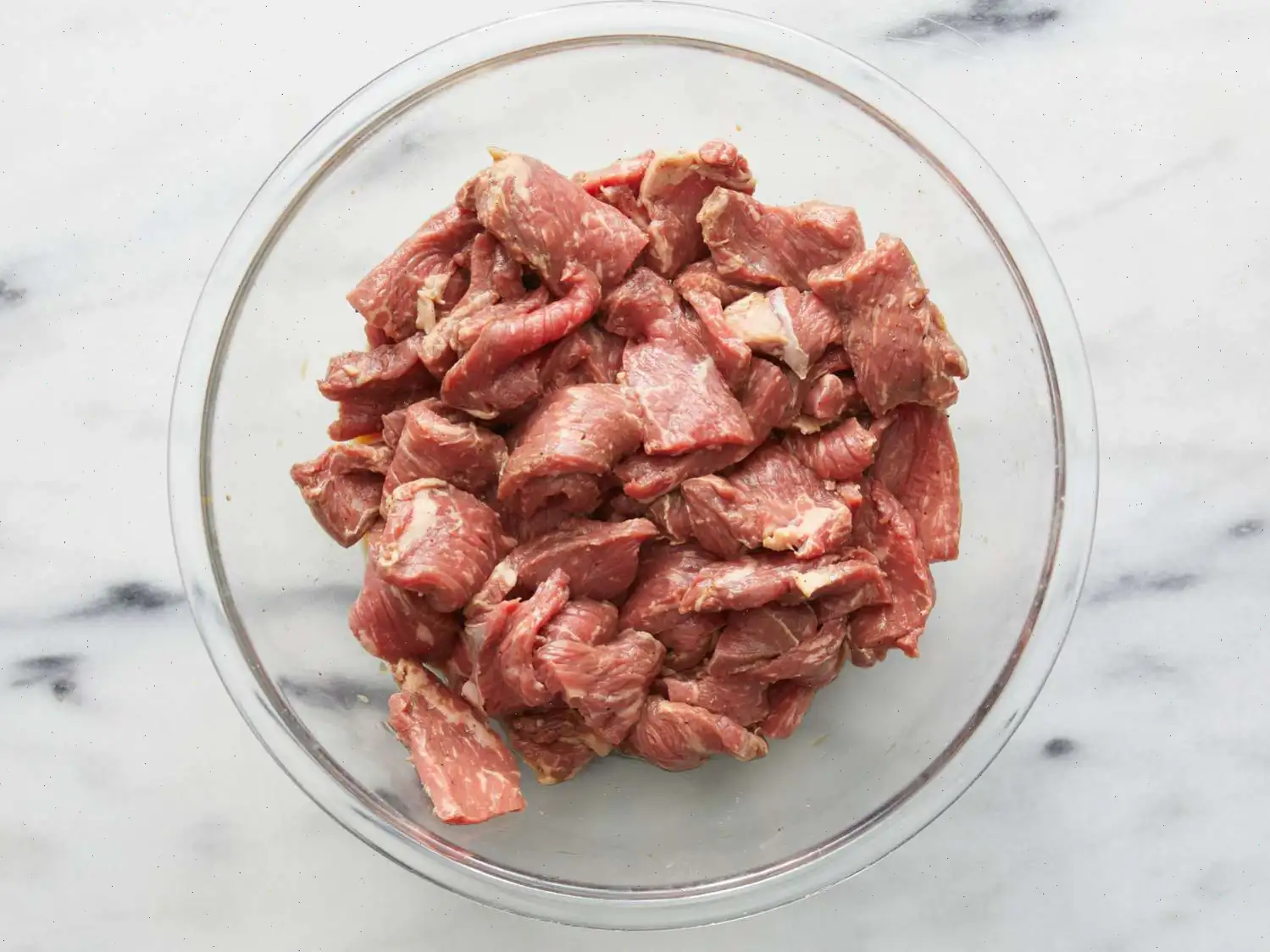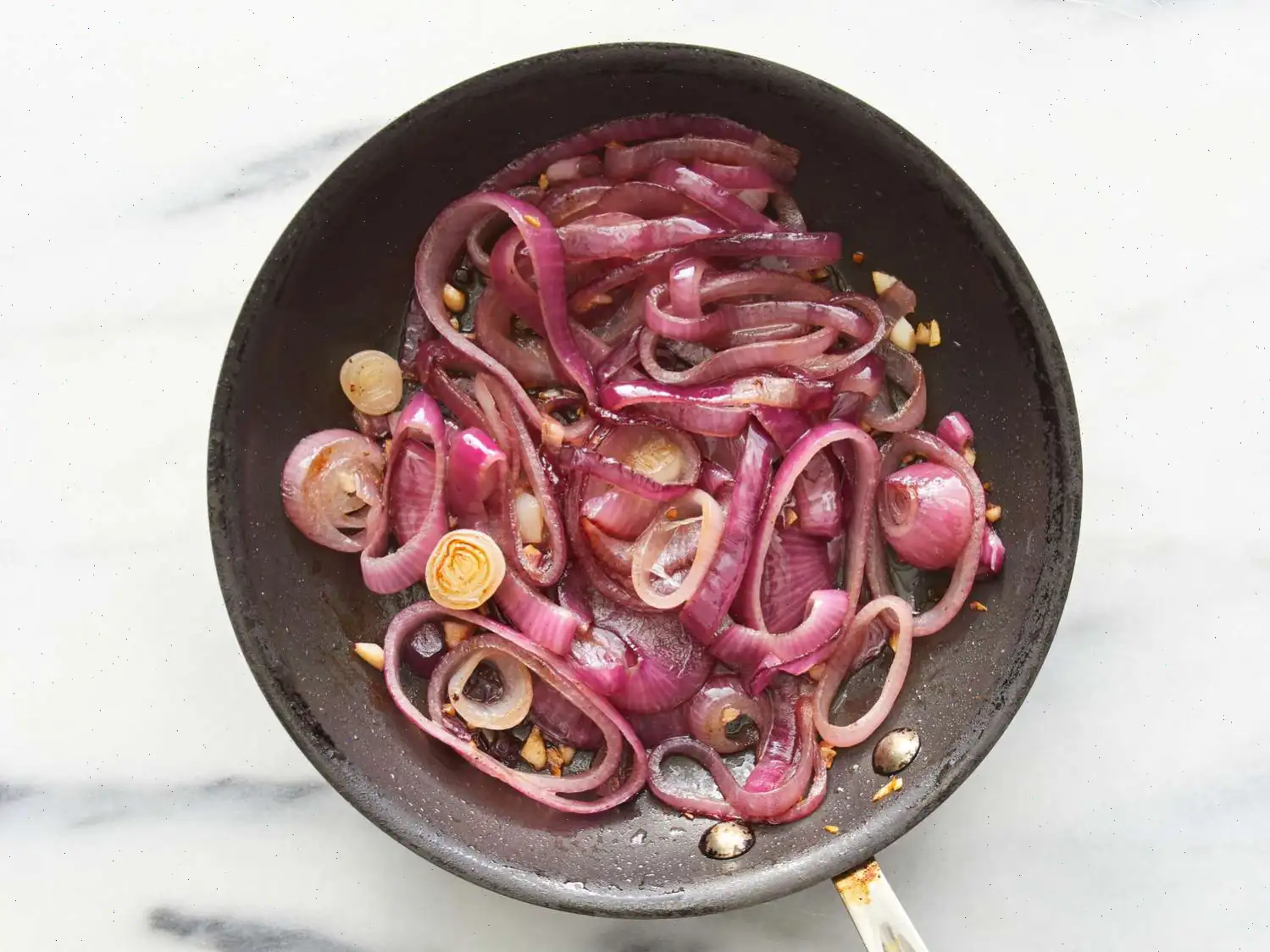
Filipino Beef Steak Recipe
Ingredients
This recipe was developed at its original yield. Ingredient amounts are automatically adjusted, but cooking times and steps remain unchanged. Note that not all recipes scale perfectly.
- 4 pounds New York strip steak, sliced thin
- 1 lemon, juiced
- 3 tablespoons soy sauce
- 1 teaspoon white sugar
- Salt and pepper to taste
- 1 tablespoon cornstarch
- 2 tablespoons vegetable oil or as needed
- 3 tablespoons olive oil
- 1 onion, sliced
- 2 cloves garlic, chopped
Directions
- Place sliced beef in a large bowl. In a separate small bowl, whisk together lemon juice, soy sauce, sugar, salt, and pepper. Pour this mixture over the beef and toss to coat. Stir in the cornstarch until evenly distributed.
- Cover the bowl and refrigerate for at least 1 hour, or up to overnight to allow the beef to marinate.
- Heat vegetable oil in a large skillet over medium heat. Remove the beef slices from the marinade, shaking off any excess liquid. Discard the remaining marinade.
- Working in batches, fry the beef slices in the hot oil for 2 to 4 minutes per side, or until they firm up and are reddish-pink and juicy in the center. Transfer the cooked beef slices to a serving platter.
- In a separate small skillet, heat olive oil over medium heat. Add the sliced onion and chopped garlic. Cook, stirring frequently, until the onion turns golden brown, about 5 to 7 minutes.
- Spoon the cooked onion and garlic mixture over the beef slices before serving.
Nutrition Facts (per serving)
| Calories | 638 |
|---|---|
| Total Fat | 47g |
| Saturated Fat | 17g |
| Cholesterol | 143mg |
| Sodium | 380mg |
| Total Carbohydrate | 4g |
| Dietary Fiber | 0g |
| Total Sugars | 1g |
| Protein | 48g |
| Vitamin C | 7mg |
| Calcium | 24mg |
| Iron | 4mg |
| Potassium | 698mg |
Servings per Recipe: 10
* Percent Daily Values are based on a 2,000 calorie diet. Your daily values may be higher or lower depending on your calorie needs.

The Filipino Beef Steak, also known as Bistek Tagalog, is a beloved Filipino dish made of thinly sliced beef marinated in a mixture of soy sauce, lemon juice, and garlic. This savory and tender steak is pan-fried and typically topped with caramelized onions and garlic, offering a unique blend of tangy and savory flavors. The dish is often served with steamed rice, making it a hearty and satisfying meal.
History and Origin of Filipino Beef Steak
The origins of Filipino Beef Steak can be traced to the Spanish colonial period in the Philippines, which lasted from 1565 to 1898. During this time, many Spanish culinary influences were integrated into Filipino cooking. The use of soy sauce, a staple in many Filipino dishes, was introduced by the Chinese and further refined by the Spanish. Bistek Tagalog is believed to be a Filipino adaptation of the Spanish dish bistec, which refers to a steak or beef cut cooked with onions and garlic. The Filipino version uses local ingredients such as calamansi (a citrus fruit), soy sauce, and the unique method of marinating and pan-frying the beef.
Regional Variations and Unique Characteristics
While the basic recipe for Filipino Beef Steak remains largely the same throughout the country, there are some regional variations. In certain provinces, particularly in the Visayas, calamansi juice is often used as a substitute for lemon juice, adding a distinct Filipino flavor. In other regions, the dish may be cooked with additional ingredients like bell peppers or even pineapple to enhance its sweetness and complexity.
What sets Filipino Beef Steak apart from other beef steak dishes is its unique marinade, which balances the acidity of citrus with the umami richness of soy sauce. The combination of garlic and onions gives the dish its characteristic aromatic flavor. The steak itself is sliced thinly, allowing the marinade to penetrate and tenderize the meat more effectively.
Serving and Popularity
Filipino Beef Steak is often served as a main dish in Filipino households, particularly for special occasions and family gatherings. It is a staple in everyday Filipino cooking and is commonly paired with steamed rice, making it a well-rounded and satisfying meal. The dish is also frequently found in Filipino restaurants, where it is enjoyed as part of a larger spread of Filipino comfort food.
Because of its popularity and simple ingredients, Bistek Tagalog has become a quintessential part of Filipino cuisine. It is beloved for its comforting, homey taste that evokes feelings of nostalgia for many Filipinos, especially those living abroad.
Interesting Facts About Filipino Beef Steak
- Filipino Beef Steak is often made with New York strip steak or sirloin, but in some regions, it can also be prepared with other cuts like flank steak or tenderloin.
- In Filipino culture, the dish is sometimes prepared during holidays or festive occasions as a way of honoring guests or family members.
- The marinade is not only a way to flavor the meat but also serves to tenderize tougher cuts of beef, making it ideal for a wide range of beef types.
- The dish has evolved over the years, with many modern cooks experimenting with additional ingredients like ginger, mushrooms, or even vinegar for added complexity in flavor.
How Filipino Beef Steak Differs from Similar Dishes
Filipino Beef Steak is similar to other Asian beef dishes, such as Japanese Gyudon or Chinese-style beef stir-fries, but it stands out due to its use of lemon juice or calamansi, which is less common in other regional cuisines. Additionally, the Filipino version is often cooked in larger slices of beef, whereas in dishes like Gyudon, the meat is usually sliced even thinner and cooked in a more brothy sauce. The distinctive inclusion of onions and garlic in the Filipino Beef Steak adds a unique aroma and flavor that differentiates it from its counterparts in other Asian cuisines.
Conclusion
Filipino Beef Steak is more than just a mealit's a piece of Filipino culinary heritage. With its tender beef, flavorful marinade, and aromatic onion and garlic topping, its a dish that speaks to the heart of Filipino cooking: simple, hearty, and full of flavor. Whether enjoyed at home or in a restaurant, it continues to be a favorite among Filipinos and food lovers around the world.
FAQ about Filipino Beef Steak Recipe
Comments
Thomas Hill
08/02/2022 05:27:24 AM
This dish was excellent! It was incredibly easy to prepare, and I had all the ingredients on hand, which made it even better. I found that slicing the steaks paper-thin while they were partially frozen made the process much easier.
Alexander Allen
03/23/2023 08:38:19 AM
I found this recipe to be simple to prepare and extremely flavorful. I paired it with rice and green beans, which complemented the dish perfectly. If I were to offer one suggestion, it would be to reduce the amount of lemon juice slightly. The lemon I used was quite large, so a smaller one may be more suitable next time. I will definitely be making this again in the future.
Ronald Parker
04/08/2025 07:14:40 AM
Excellent dish! I grilled the onions and garlic before adding the marinated steak, allowing the flavors to meld together perfectly. This is a recipe I will certainly be making again!
Kimberly Adams
11/24/2024 02:20:27 AM
You'll need to use a generous amount of marinade, especially when preparing 4 lbs of meat as suggested in the recipe. However, the end result is fantastic! This recipe also pairs beautifully with sliced pork butt.
Catherine Roberts
12/06/2023 02:05:29 AM
I loved how simple this recipe was and that I had all the ingredients readily available. The dish turned out to be delicious! I paired it with some white rice seasoned with salt, butter, and garlic.
Gregory Martin
10/12/2022 11:53:46 AM
Review: This dish turned out amazing! I opted for calamansi juice over lemon juice, sliced the onions instead of chopping them, and doubled the garlic. Following the true Filipino tradition really enhanced the flavors of this delicious beef steak. And it's a must to serve it over a bed of rice.
Frank Carter
09/25/2022 02:08:06 AM
Despite not using NY strips as called for in the recipe, I substituted with sirloin tip and the dish still turned out fantastic. The recipe was great, and my family absolutely loved it. Thank you for sharing! :)
Nicholas King
04/08/2025 11:46:17 PM
Extremely flavorful and succulent
Michael Ramirez
04/10/2023 02:54:39 AM
Great recipe, but it requires a bit more marinade to really make the flavors pop. I ended up adding extra marinade, which made it slightly too tangy, prompting me to balance it out with more lemon and soy sauce. That was on me... I transferred the marinade and cooked onions to a separate pot, then thickened the sauce with cornstarch. My husband enjoys pouring it over his rice. While my dad's version of this dish doesn't include sugar, it still reminded me a lot of his recipe.











